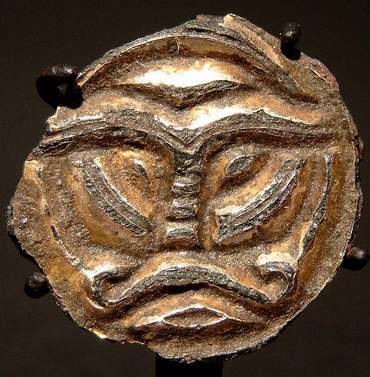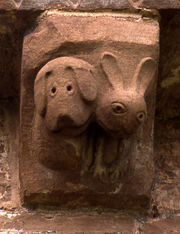
Image Index
The following is a more in-depth description of each of the Anglo-Saxon images that have appeared on the website. They are listed here, in the same order as you have been introduced to them.

This is a photograph of a ninth century Anglo-Saxon coin. The face of this coin reads: Northumbria Aethelred II 854-62, Æ Sceat, 85Y-58, O: † Ediiredre, †, Rx: † Eurdreo †. Although this object is hundreds of years old it is still with us today, providing a small window into an intriguing past culture. While Anglo-Saxon coins are now sold among historical enthusiats and kept in museums, it is important to acknolwedge that this coin was once a daily part of people's lives. It was passed from hand to hand, exchanged hundreds of times and perhaps even used to pay wergild. Wergild was like an ancient form of life insurance; the legal money-equivalent of a person's value. If you killled someone, for example, out of respect for the victim's family you would pay them a sum of money; there were specific amounts for limbs lost and so on. With this one little coin comes a great deal of history.

This is a photograph of the now widely recognized parade helmet found at Sutton Hoo in 1939. It was discovered along with a series of other historically important artifacts that have shed some light on on the early medieval period in England. This particular helmet took its design from the late Roman spangenhelm style. It is in remarkably good condition and still has a strong and commanding presence hundreds of years after it was last worn.

This is a picture of a fifth-sixth century Anglo-Saxon brooch made of gilt copper-alloy. If you look carefully you can see a face with a long moustache decorating its front. Although it is slighty worn it is in incredible shape considering its age. Those who could afford jewelry would have used brooches ornamentally and also to clasp clothing together. Anglo-Saxon jewelery was often both purposeful and decorative.

The above image is a late eighth century Anglo-Saxon mount with four two-legged horned beasts interlaced on its surface, an equisite piece made of gilt bronze. At first glance it is difficult to notice the animals because they are so stylized, but with a closer look they become visible. Mounts were used to reinforce the fabric bands on a variety of objects such as belts and straps. Can you imagine having such a beautiful contraption adorn your clothing?

This is a reproduction of an Anglo-Saxon cloisonne buckle with intertwined animals and is made of cut glass in soldered cells. Most of our jewerly today is made on a production line, whereas the Anglo-Saxons hand-made every individual piece, spending hours designing and shaping their creations. Modern admirers have often undertaken the task of trying to create jewerly in the Anglo-Saxon style through the use of traditional methods.

This intriging object is a ninth century Anglo-Saxon strap-end from Yorkshire, England. It is made of silver and contains beautiful engraving work. A strap-end is essentially an ancient kind of belt-buckle which resided on the end of the belt. They were often very decorated for ornamental purposes and were riveted or sewn onto the belt itself.

This is a photograph of a metal Anglo-Saxon spear head. It would have been attached to a long shaft of wood, creating an excellent tool for men to use in both hunting and fighting. The spear was an important part of Anglo-Saxon culture as it had the power to bring both food and protection. Many men were found buried with their spears, revealing Anglo-Saxon concepts of gender division and manhood.

This is a wonderful reconstruction of an Anglo-Saxon ship based on the Sutton Hoo excavation. The ship at Sutton Hoo was found buried underneath the earth with an extensive tomb and treasures hidden within, showing the immense significance of ships, trade and travel to this past culture. The Anglo-Saxons were excellent sailors who used the hwæl-weg (whale-way/ocean) on a daily basis. Can you imagine the man-power it would take to row this large, hand-made ship?
The above are reproductions of traditional Anglo-Saxon and Viking helmets. The helmet on the top left is in the ninth-eleventh century conical style and has decorative eyebrows on its face. The top right helmet is also conical, consisting of four seperate pieces with large cheekflaps; it is in an eleventh-twelfth century style. The bottom left helmet is a reproduction of a standard ninth-eleventh century four piece conical. The center is a spectacle helmet, in ninth-tenth century Norway style. The last helmet on the left is an eleventh-twelfth century one-piece conical. While such pieces might be relatively simple for us to reproduce today, the original helmets were all constructed individually wih limited technology and tools. Each helmet was hand-crafted, with many hours going into its construction.
This is a picture of the ninth century Strickland brooch. There is a stylized cross on its face and if you look carefully you can see beasts and other dog-like creatures filling the space around its central design. A beautiful work of ornamentation, consider again how long it must have taken to make this piece. It consists of silver inlaid with niello, blue and gold glass, all completed by the work of human hands.
The above is an image of an Anglo-Saxon gold pendant from circa 680 AD. Besides for the small dent in its dome it is in very good condition. Surrounding the center are three beaded circles, adding to the ornament's already magestic quality. This pendant would have been attached to a gold chain and worn around the neck. Gold, which we see referenced a great deal in Old English texts, was something that people would have been regularly exposed to, whether they were wealthy and owned it themselves or seen it adorning others.
This is a beautiful photograph of a sixth century Anglo-Saxon wrist clasp, made of gilt silver with remains of niello. These pieces were used to clasp leather bands around the wrist, similar to modern day bracelets. The left side of the clasp is engraved with two beasts, each eating a small one and the right side has two smaller creatures facing eachother eating yet a smaller animal. At first glance these beasts are difficult to see because of their artistic styilization. While we are accustomed to seeing artifacts like this today in museums or private collections, we must remember that people wore these gorgeous ormanents regularly if they had the means to do so.
This is a picture of a thirteenth century stone corbel at Boyle Abbey, County Roscommon, Ireland. It sits on the North West crossing pier of the abbey. Corbels are essentially large pieces of stone that are attached to the main structure of buildings in order to carry extra weight, usually supporting projecting parapets or walls. While some have are very simple in design others are elegantly carved and sculpted. The Anglo-Saxons would have been accustomed to seeing this kind of architecture on local buildings.

For comparison purposes, the above is an example of a corbel of a rather different style. Although this corbel was carved during the mid twelfth century, it has charming, cartoon-like and almost modern looking depictions of a dog and a rabbit. This particular corbel is a Norman example from a church found at Kilpeck, Herefordshire and shows the stark contrasts and wide range of design of this interesting architectural form.
This is a beautiful photograph of an Anglo-Saxon ring, circa tenth century. The ring's center is extremely well made, consisting of fine quality gold wire with green and white enamel. The actual band of the ring is not of the same quality, indicating that it was perhaps made by two different individuals. The time that would have gone into making such an equisite ornament is quite phenomenal. This ring could have been worn by either sex, as it is quite a large piece. It was found near Warwick and now belongs to the Warwickshire Museum.

The above is a page from the Beowulf manuscript which can now be found at the British library. I highly recommend Seamus Heaney's translation of the enjoyable epic poem. In 1731 the manuscript was almost destroyed in a fire, but is thankfully still with us today and can now be accessed in electronic form. The manuscript itself is relatively small, aproximately five inches by eight inches. I have included an image of the original text so that you can see how the Anglo-Saxon language was actually written. Old English looks very different when it is reprinted in Times New Roman font or when it is reproduced online in a format like this one. As you can see the Old English characters were very stylized and elegant. The manuscript itself is made of parchment (treated animal skin) and thus some holes exist where the creature might have had an insect bite or small sore.